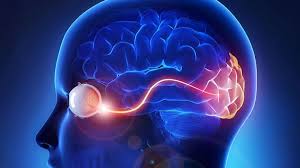
The optic nerve, also known as Cranial Nerve II (CN II), is a vital component of the visual system. It’s often described as the “cable” or “messenger” that transmits visual information from your eye to your brain.
Here’s a breakdown of what the optic nerve is and how it functions:
What it is:
- Bundle of Nerve Fibers: The optic nerve is essentially a bundle containing over a million nerve fibers (axons of retinal ganglion cells).
- Connection between Eye and Brain: It starts at the back of each eye, specifically at a point called the optic disc (where the nerve fibers converge and exit the eye), and travels to the brain.
- Part of the Central Nervous System (CNS): Uniquely among the cranial nerves, the optic nerve is technically considered part of the central nervous system (along with the brain and spinal cord) rather than the peripheral nervous system. This is because it develops as an outgrowth of the brain during embryonic development. This distinction means it’s myelinated by oligodendrocytes (CNS cells) and encased within the meninges (the protective layers surrounding the brain and spinal cord), unlike other peripheral nerves.
How it Functions (Its Role in Vision):
- Light Detection: When light enters your eye, it passes through the cornea and lens and is focused onto the retina at the back of your eye.
- Signal Conversion: The retina contains specialized light-sensitive cells called photoreceptors (rods and cones). These cells convert the light into electrical impulses.
- Transmission to Brain: These electrical impulses are then passed to other cells in the retina, eventually reaching the retinal ganglion cells. The axons of these ganglion cells converge to form the optic nerve.
- Information Relay: The optic nerve carries these electrical signals, which represent visual information (brightness, color, contrast, shape, movement), directly to the brain.
- Processing in the Brain: The optic nerves from both eyes meet at a structure called the optic chiasm, where some nerve fibers cross over to the opposite side of the brain. From there, the visual information travels along pathways (optic tracts and optic radiations) to the visual cortex in the occipital lobe of your brain, where the signals are processed and interpreted as the images you see.
Beyond Conscious Vision (Reflexes and Circadian Rhythm):
A small portion of the optic nerve fibers branch off before reaching the visual cortex. These fibers play a role in:
- Pupillary Light Reflex: They help control the automatic adjustment of your pupils to let more or less light into your eye.
- Accommodation Reflex: They contribute to the muscles that adjust the shape of your eye’s lens to focus on objects at different distances.
- Circadian Rhythm: They send signals about light exposure to areas of the brain that help regulate your body’s internal clock, influencing your sleep-wake cycle and other biological processes.
Importance:
The optic nerve is absolutely essential for sight. Any damage or disruption to the optic nerve can lead to various vision problems, ranging from blurred vision and pain to partial or complete vision loss. Common conditions affecting the optic nerve include:
- Glaucoma: A group of diseases that often cause increased pressure inside the eye, damaging the optic nerve.
- Optic Neuritis: Inflammation of the optic nerve, often associated with autoimmune conditions like multiple sclerosis.
- Optic Neuropathy: General damage to the optic nerve due to various causes like poor blood flow, disease, or trauma.
